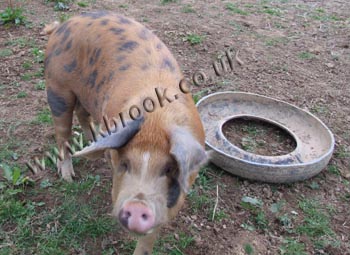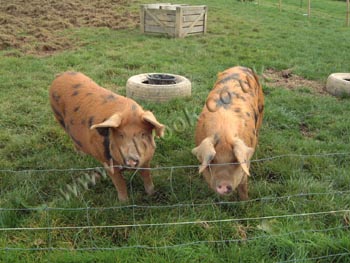PIG CARE

Caring for your pig is not just about it’s physical being but also about the pig care of its surroundings for example, if you have decided to create your own pig arc or just doing some general touching-up to their housing or any other equipment associated with your pigs please make sure you use paints or wood preservatives that are safe to use with your pig or any animal for that matter. There is a risk of lead poisoning from old paintwork, especially if you use second-hand building materials.
On days when the rain just does not want to stop and the ground is boggy you can bet that your pigs will not be enjoying the weather, as boggy, wet and cold weather sometimes can be a recipe for disaster as invariably pigs being of their large size can quite easily do themselves damage by twisting their legs, pulling a muscle or at worst breaking a leg. So on these miserable days I bring my girls in for a couple of days just to give them a break from the miserable weather and they are very appreciative.
Your Oxford Sandy & Black pig must be able to stand up lie down and rest without difficulty have a clean, comfortable and adequately drained place in which to rest, be able to see other pigs (unless isolated for the visiting vet) and maintain a comfortable temperature.
When moving your Oxford Sandy & Black, move them at their own pace and they should be encouraged gently, especially around corners and where it is slippery underfoot. Avoid too much noise, excitement or force and not put pressure on, or strike your pig. Steep slopes can cause leg problems and should be avoided.
Be vigilant about air circulation, dust, temperature, and humidity. When in summer and temperatures are high ensure that they have wallows, a shower would be greatly appreciated.
Excessive heat loss should also be prevented either by insulation or by the provision of adequate bedding. Straw bedding generally decreases temperature requirements.
Fluctuations in temperature in housing should be avoided as it can create stress that could lead to aggression or disease such as pneumonia.
You should also, where possible, avoid sudden and unexpected noises such as loud bells, shotguns, barking dogs and so forth as these can also stress the pigs. With this said they should be use to all noises that happen during the day it is at night when even us humans become very uncomfortable about sudden noises and if your sow is in pig around Christmas or Bonfire Night or New Years Eve then the use of fireworks when they are tucked up in bed could result in your pig or any livestock for that matter aborting. There again if you are living in an agricultural environment then there is a code of farming etiquette and you will find that this rarely happens and if it does a little friendly phone call wouldn’t hurt.

Automatic equipment such as drinkers should be inspected at least once a day to check they have no defects. Pigs are very strong and can easily chew through plastic pipes, push over unstable feeders or drinkers, lift gates off their hinges and so forth.
A written health and welfare plan is always useful. The plan should be reviewed and updated at least once a year. It should encompass policies to prevent, treat or limit existing disease problems and should include enough records to enable you to assess your herd’s output and monitor the welfare of your pigs. The plan should also look at bio-security arrangements (reducing the risk of disease occurring or spreading to other animals). Good bio-security arrangements can be achieved through good management and hygiene, reduction of stress and effective disease control systems such as vaccination and worming programmes. Bio-security results in security from the introduction of infectious diseases and the spread of any diseases on the holding. Although such plans apply more to large-scale farmers, the same principles do relate to those operating on a smaller scale.
You must be knowledgeable and competent in a wide range of health and welfare skills including handling pigs, preventing and treating lameness, avoiding parasites, providing appropriate care to sick and injured pigs, caring for sows and their litters, giving injections and managing pigs to minimise aggression. Specific training should be given for specific tasks such as artificial insemination. Incoming stock presents the greatest risk to the health of pigs as regards infectious disease. You should have isolation facilities if you expect to have new animals coming onto your land, where they can be kept for a suitable period before joining the existing animals.
Your Oxford Sandy & Black pig should be inspected regularly, as should any equipment used. Signs of ill health should be looked for and problems should be anticipated or recognised in their earliest stages. If the cause of ill health is not obvious, or if your immediate action is not effective, a vet or other expert should be called in at once. From young, especially those of you who wish to keep the Oxford Sandy & Black for breeding, I always advocate to all my new piggy people that A LOT of human interaction is paramount from an early age this will stand you in good stead when they are older and are of a size to be respected. Because I have put a lot of time and effort into my girls I am able to cut their nails where necessary, clean their ears, put my hands in their mouth (as one had a twig stuck between its teeth which I had to prize out!) and check their eyes (I have had to take a blade of grass out before now!) and all of this is done without fuss but rewarded with some juicy treat – of course!